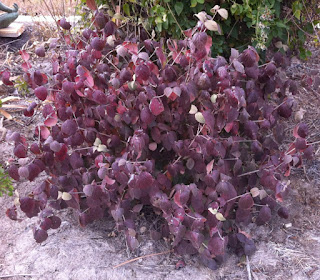 I realized, today, that not only have I been busy this week and not posted at all, it has also been a few weeks since I waxed poetic about a rose. In fact, Spring had better come fast because I may be running out of roses about which to wax. Not. Regardless, a quick check of my photo collection served to remind me that I have neglected one of the best of Dr. Griffith Buck's roses; the beautiful and sumptuous 'Hawkeye Belle'.
I realized, today, that not only have I been busy this week and not posted at all, it has also been a few weeks since I waxed poetic about a rose. In fact, Spring had better come fast because I may be running out of roses about which to wax. Not. Regardless, a quick check of my photo collection served to remind me that I have neglected one of the best of Dr. Griffith Buck's roses; the beautiful and sumptuous 'Hawkeye Belle'.'Hawkeye Belle' is a pink blend shrub rose bred by Dr. Buck and introduced in 1975. It is officially a medium pink, but in fact, I think 'Hawkeye Belle' is the perfect shade of pink; not too brazen, not too blue, and not too white. This is a pink (RHSCC 159D according to Dr. Buck) that goes with any other rose you want arrange it with and the centers tend to age deeper pink than the outer petals. Describing 'Hawkeye Bell' as a shrub rose is placing a label on it that is too awkward for the reality. The flowers are not the haphazard mishmash of Modern Shrub roses, they are more Hybrid Tea in character, albeit a very double Hybrid Tea four-inch diameter bloom with 38-45 petals. Flowers are moderately fragrant The bush is also more like a Hybrid Tea in form, standing about 4 foot tall and 3 foot around in my garden at maturity. Canes are stiff, thick, and healthy, more resistant than many of my roses to the Kansas winds that try to break them off. The foliage is dark green and shiny, moderately resistant to blackspot, and new foliage is tinted red. I think I noted in an earlier post that about 10% of the foliage succumbs to blackspot during an average summer here.
.jpg) I always think of 'Hawkeye Belle' as royalty, descended as she is from a seedling of 'Queen Elizabeth' X 'Pizzicato', crossed with pink shrub 'Prairie Princess'. Since 'Pizzicato' was also a pink shrub, it is no wonder that 'Hawkeye Belle' is the epitome of dainty pink, able to mix with common folk as well as with more refined roses. This is a rose that I often bring inside, extending her domain from the harsh burning garden to shaded home where she is better appreciated. She does well outside, though, continuing to bloom through the hottest stretches of summer and braving the best that my now Zone 6A climate can offer. A commenter on helpmefind.com indicated that, unlike most roses bred for the Midwest, 'Hawkeye Belle' is also "exquisite" and disease resistant in California. Only in the wettest Spring does she acknowledge the weather, balling up a bit when it is wet and chilly. 'Hawkeye Belle' is hardier to colder climates in mine; she was labeled a Rose of the Month in June 2006 by the Twin Cities Rose Club.
I always think of 'Hawkeye Belle' as royalty, descended as she is from a seedling of 'Queen Elizabeth' X 'Pizzicato', crossed with pink shrub 'Prairie Princess'. Since 'Pizzicato' was also a pink shrub, it is no wonder that 'Hawkeye Belle' is the epitome of dainty pink, able to mix with common folk as well as with more refined roses. This is a rose that I often bring inside, extending her domain from the harsh burning garden to shaded home where she is better appreciated. She does well outside, though, continuing to bloom through the hottest stretches of summer and braving the best that my now Zone 6A climate can offer. A commenter on helpmefind.com indicated that, unlike most roses bred for the Midwest, 'Hawkeye Belle' is also "exquisite" and disease resistant in California. Only in the wettest Spring does she acknowledge the weather, balling up a bit when it is wet and chilly. 'Hawkeye Belle' is hardier to colder climates in mine; she was labeled a Rose of the Month in June 2006 by the Twin Cities Rose Club.
For my Kansas garden, 'Hawkeye Belle' has always been a dependable performer. I have two bushes, one that survived from my first days out of the city and another that I planted later into my more formal rose bed as a cutting from the first. i hope she does as well in your garden as she has in mine.


.jpg)
.jpg)
.jpg)
.jpg)
.jpg)
.jpg)

.jpg)







.jpg)
.jpg)
.jpg)
.jpg)
.jpg)
.jpg)
.jpg)
.jpg)






.jpg)
.jpg)

.jpg)
.jpg)
.jpg)
.jpg)
.jpg)
.jpg)
.jpg)
.jpg)
.jpg)
.jpg)
.jpg)
.jpg)

.jpg)
